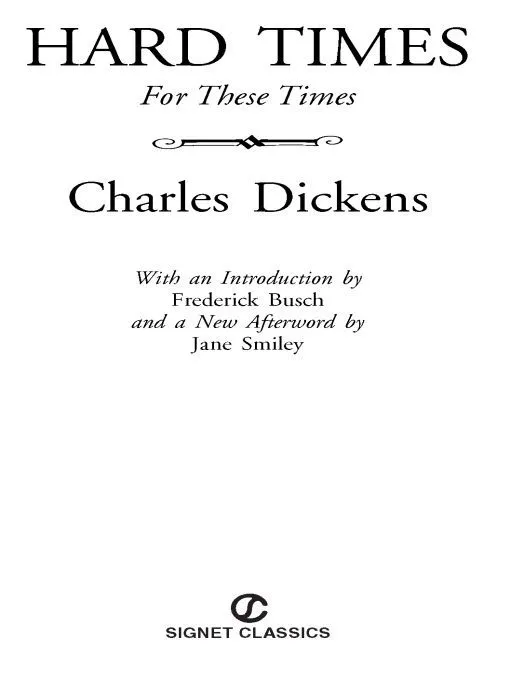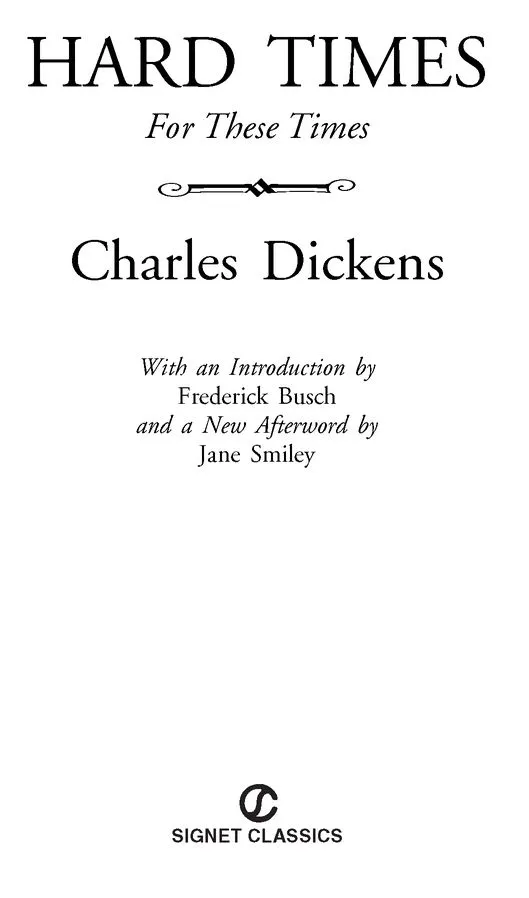Hard Times

Table of Contents
Title Page
Copyright Page
Introduction
Dedication
BOOK THE FIRST
CHAPTER I - The One Thing Needful
CHAPTER II - Murdering the Innocents
CHAPTER III - A Loophole
CHAPTER IV - Mr. Bounderby
CHAPTER V - The Keynote
CHAPTER VI - Sleary’s Horsemanship
CHAPTER VII - Mrs. Sparsit
CHAPTER VIII - Never Wonder
CHAPTER IX - Sissy’s Progress
CHAPTER X - Stephen Blackpool
CHAPTER XI - No Way Out
CHAPTER XII - The Old Woman
CHAPTER XIII - Rachael
CHAPTER XIV - The Great Manufacturer
CHAPTER XV - Father and Daughter
CHAPTER XVI - Husband and Wife
BOOK THE SECOND
CHAPTER I - Effects in the Bank
CHAPTER II - Mr. James Harthouse
CHAPTER III - The Whelp
CHAPTER IV - Men and Brothers
CHAPTER V - Men and Masters
CHAPTER VI - Fading Away
CHAPTER VII - Gunpowder
CHAPTER VIII - Explosion
CHAPTER IX - Hearing the Last of It
CHAPTER X - Mrs. Sparsit’s Staircase
CHAPTER XI - Lower and Lower
CHAPTER XII - Down
BOOK THE THIRD
CHAPTER I - Another Thing Needful
CHAPTER II - Very Ridiculous
CHAPTER III - Very Decided
CHAPTER IV - Lost
CHAPTER V - Found
CHAPTER VI - The Starlight
CHAPTER VII - Whelp-hunting
CHAPTER VIII - Philosophical
CHAPTER IX - Final
Afterword
Selected Bibliography
A Note on the Text
As a child, Charles Dickens (1812-70) came to know not only hunger and privation, but also the horror of the infamous debtors’ prison and the evils of child labor. A surprise legacy brought release from the nightmare of prison and “slave” factories and afforded Dickens the opportunity of two years’ formal schooling. He taught himself shorthand and worked as a parliamentary reporter until his writing career took off with the publication of Sketches by Boz (1836) and The Pickwick Papers (1837). As a novelist and magazine editor, Dickens had a long run of serialized success through Our Mutual Friend (1864-65). In later years, ill health slowed him down, but he continued his popular dramatic readings from his fiction to an adoring public, which included Queen Victoria. At his death, The Mystery of Edwin Drood remained unfinished.
Frederick Busch was the author of eighteen works of fiction, including Closing Arguments, Girls, and The Mutual Friend, a novel about Charles Dickens. The winner of numerous awards, he was the Fairchild Professor of Literature at Colgate University.
Jane Smiley is an American novelist. In addition to her many novels (including Ten Days in the Hills, Horse Heaven, and A Thousand Acres), she wrote a short biography of Charles Dickens for the Penguin Lives series (2001).

SIGNET CLASSICS
Published by New American Library, a division of
Penguin Group (USA) Inc., 375 Hudson Street,
New York, New York 10014, USA
Penguin Group (Canada), 90 Eglinton Avenue East, Suite 700, Toronto,
Ontario M4P 2Y3, Canada (a division of Pearson Penguin Canada Inc.)
Penguin Books Ltd., 80 Strand, London WC2R 0RL, England
Penguin Ireland, 25 St. Stephen’s Green, Dublin 2,
Ireland (a division of Penguin Books Ltd.)
Penguin Group (Australia), 250 Camberwell Road, Camberwell, Victoria 3124,
Australia (a division of Pearson Australia Group Pty. Ltd.)
Penguin Books India Pvt. Ltd., 11 Community Centre, Panchsheel Park,
New Delhi - 110 017, India
Penguin Group (NZ), 67 Apollo Drive, Rosedale, North Shore 0632,
New Zealand (a division of Pearson New Zealand Ltd.)
Penguin Books (South Africa) (Pty.) Ltd., 24 Sturdee Avenue,
Rosebank, Johannesburg 2196, South Africa
Penguin Books Ltd., Registered Offices:
80 Strand, London WC2R 0RL, England
Published by Signet Classics, an imprint of New American Library, a division of Penguin Group (USA) Inc.
First Signet Classics Printing, July 1961
First Signet Classics Printing (Smiley Afterword), July 2008
Introduction copyright © Penguin Group (USA) Inc., 1997 Afterword copyright © Jane Smiley, 2008
eISBN : 978-1-101-04219-9
All rights reserved
 REGISTERED TRADEMARK—MARCA REGISTRADA
REGISTERED TRADEMARK—MARCA REGISTRADA
The scanning, uploading, and distribution of this book via the Internet or via any other means without the permission of the publisher is illegal and punishable by law. Please purchase only authorized electronic editions, and do not participate in or encourage electronic piracy of copyrighted materials. Your support of the author’s rights is appreciated.
http://us.penguingroup.com
Introduction
MUDDLE
Charles Dickens’ tenth novel, Hard Times: For These Times, was the first of his own books to be serialized in Household Words, the magazine he edited for his publishers, Bradbury and Evans. It is about a culture in which everything is for sale, especially human beings, who in the novel are enslaved by others for the sake of profit or career. The actual lives of men and women are sacrificed by others on the altar of their own need, and many of this novel’s characters are castaways. Nothing, at last, is of value to the villains of the novel—they are the manufacturers, the government, the spouses or the blood relations of their victims—except their own advantage. Dickens writes, then, of a world of social Darwinism and domestic breakdown in which those with power devour those with less or none. While comedic elements are threaded through the fabric of the novel, it is woven mostly of disapproval, disappointment, and dismay.
Though Dickens’ separation from his wife, Kate, and his liaison with Ellen Ternan, a young actress, took place years after this book’s writing, it is customary for students of Dickens to assume that he was domestically unhappy at the time of the novel’s composition, the spring and summer of 1854. Furthermore, his social criticism was continuous with his being a writer. He had always frowned at his age’s willingness to convert human misery into profits of one kind or another, as we see in his earliest journalism, collected in 1836 as Sketches by Boz. There, he describes an impoverished neighborhood, showing us milliners’ apprentices as “poor girls!—the hardest worked, the worst paid, and too often, the worst used class of the community.” And there, he describes a penniless mother and her infant: “The tears fall thick and fast down her own pale face; the child is cold and hungry, and its low half-stifled wailing adds to the misery of its wretched mother, as she moans aloud, and sinks despairingly down, on a cold damp doorstep.”
It is worth our noting that the unfortunate girls and mother are represented generically—we study them as types. Anger, and the demands of newspaper space, reduce them while distinguishing them for Dickens’ reader. They matter, and yet they are nameless representatives who demonstrate a problem but whom, in Dickens’ prose, we cannot know. The best of intentions diminish people Dickens would elevate.
It is Dickens’ anger in Hard Times that George Bernard Shaw praises, instructing readers to
bid adieu now to the light-hearted and only occasionally indignant Dickens of the earlier books . . . now that the occasional indignation has spread and deepened into a passionate revolt against the whole industrial order of the modern world.
The “modern world” of which Shaw speaks is represented by a triumphant industrial, colonialist England portrayed in the novel.
1 comment